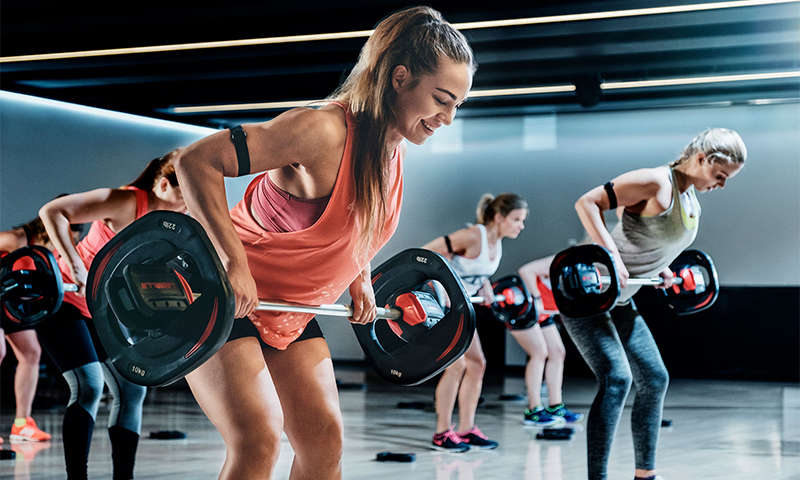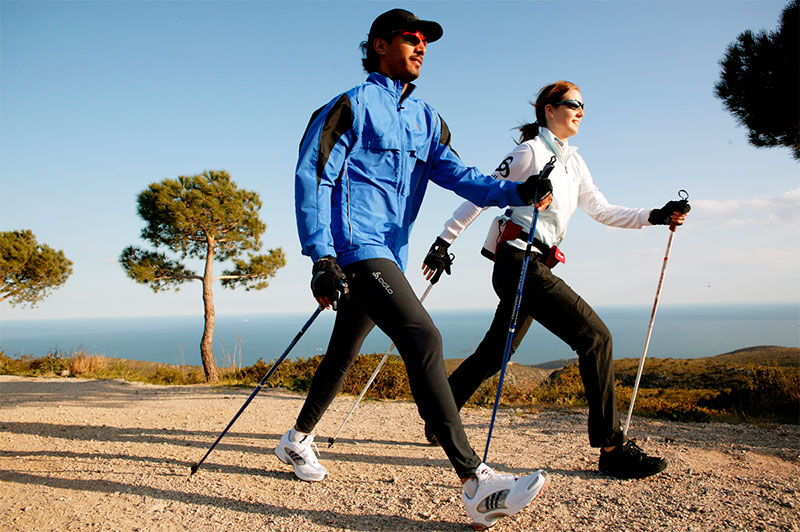Elliptical trainer helps to develop almost all muscle groups, simultaneously using the legs, arms, back, shoulders, abs and buttocks. Classes on the cross-trainer strengthen the cardiovascular system and at the same time completely harmless to the joints. And this is a great way to get rid of extra pounds. In fact, you get an exercise bike, a stepper and a treadmill in one compact package. And although from this position the purchase looks very profitable, without knowing all the nuances of choice, you risk wasting money. How to avoid this, tell our experts.

Content:
The best manufacturers of elliptical trainers - which company to choose
In the world of sports equipment for training a few big names, but they are the guarantor of the quality and reliability of simulators. Large companies closely cooperate with physicians and athletes, developing truly effective equipment for people of varying degrees of training.
So when buying ellipsoids, it is better to choose models of famous brands:
1. Body sculpture
2. Intensor
3. Spirit
4. Proxima
5. Infiniti
You will find the most reliable and functional copies from these manufacturers in ranking best ellipses. But since the elliptical trainer is a rather serious device, you should not focus only on the name. Make the right choice will help you sober assessment of their physical abilities and the ability to understand the basic characteristics of sports equipment.
The principle of operation and the device elliptical trainer
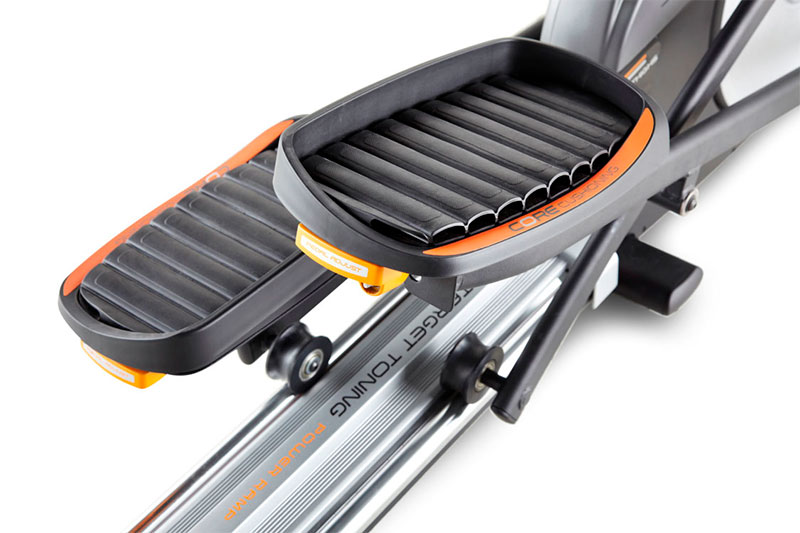
Elliptical trainer consists of the following parts:
1. Stable frame on non-slip supports (or wheels, if the model is dimensional).
2. Large step-pedals connected to the flywheel and movable handrails.
3. Resistance block - mechanical, magnetic or electromagnetic.
4. A microcontroller or a simple computer.
5. Cardiac sensors (not available on all models).
The principle of operation of an elliptical trainer is simple: a person needs to take up handrails, step on the pedals and alternately push them, “walking” forward and helping himself with his hands - something like skiing on steps.
The elliptical trajectory along which the legs move creates a feeling of weightlessness, while almost completely unloading the spine. On this simulator, you can do for a long time without harm to the body and at the same time to pump muscles well thanks to the built-in resistance unit.
Types of elliptical trainers
Mechanical
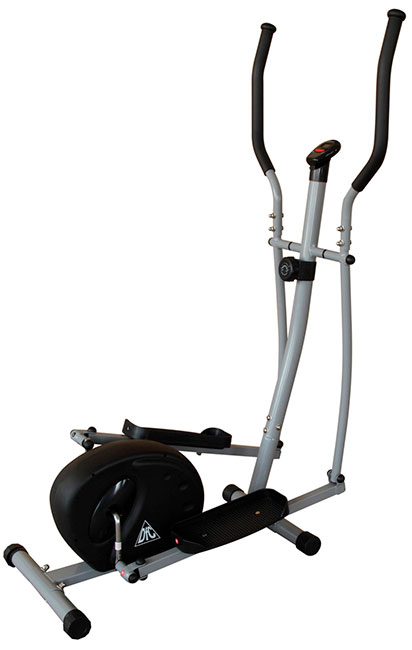
Mechanical ellipsoids are the simplest and cheapest devices. Such models are driven by a belt drive connecting the pulley and the heavy flywheel. The latter may be in front of the athlete, and behind him. The mechanical device withstands the weight of the “walker” up to 120 kg and is quite large in size, reaching 250x85x180 cm. The number of loading modes is limited.
Pros:
- Simple and quite maintainable design;
- Excellent study of all muscle groups;
- Simple load adjustment;
- Low cost.
Minuses:
- Very noisy;
- No smoothness.
Magnetic
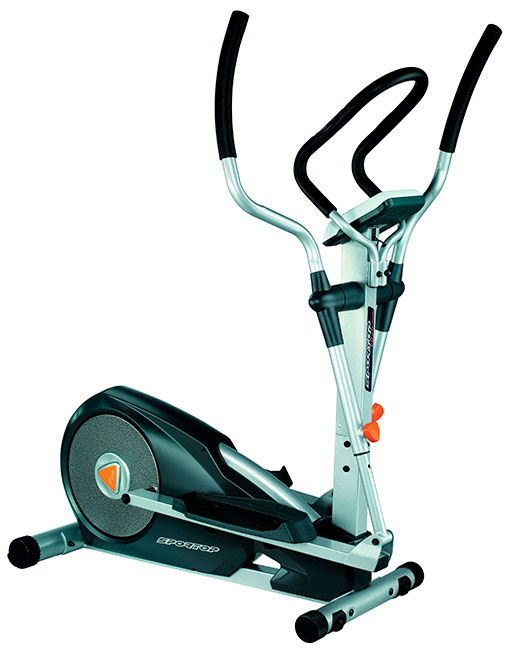
Here, the built-in magnet resists the movement: approaching the flywheel, it starts to slow down, and moving away from it loses the force of attraction. As a result, it is possible to achieve a good smoothness and increase the safety of training.
Magnetic models are able to withstand the weight of an athlete up to 180 kg, although the average for them indicator of "carrying capacity" is 100-125 kgOn the device you can set up to 30 load levels and use about 13 different workout programs, if there is a built-in microcomputer. Overall dimensions of magnetic cross-trainers usually do not exceed 160x70x120 cm.
Pros:
- Compactness;
- Variability of load levels;
- High smoothness and shift;
- Quiet operation;
- Availability of pulse sensors.
Minuses:
- Not the lowest cost.
Electromagnetic
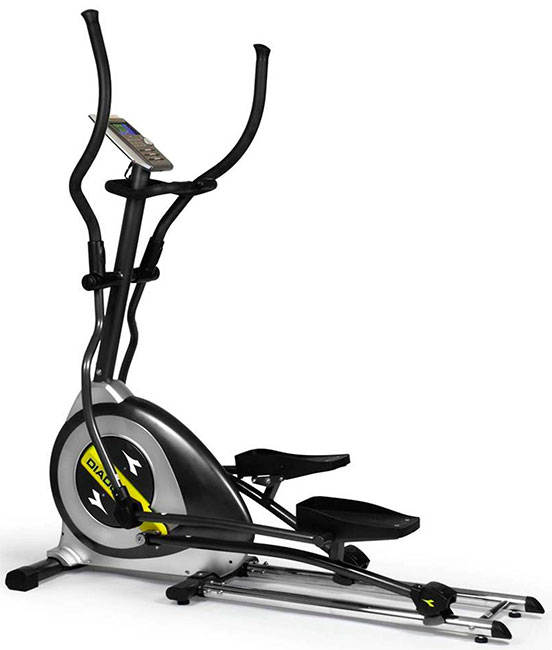
The most expensive and most functional elliptical trainers of all. Resistance in these models create magnets, which controls the drive. Such simulators are always tightly stuffed with smart electronics and capable of creating dozens of different levels of load with smooth switching.
The step length in EM-ellipsoids ranges from 45 cm to 1 m, since these are mainly professional models. Such simulators weigh up to 200 kg, and their sizes reach 260x105x185 cm. The “capacity” of electromagnetic cross-trainers has also increased - people weighing up to 130–180 kg can safely practice them.
Pros:
- Multifunctional;
- Silent;
- Able to create any level of load;
- A huge number of programs;
- The abundance of sensors that monitor the status of the athlete;
- Very durable, because there are few moving parts that could break.
Minuses:
- Overall and heavy;
- Requires electrical connection;
- Cost much.
Aeromagnetic

Unlike previous models, such simulators can work both from the network and from the built-in generator, and they deserve their “aero” prefix due to the magnet blowing system. As a rule, their stride length does not exceed 30-40 cm, and even the air cross-trainers themselves are very compact due to the vertically mounted working unit.
The maximum size of the protruding elements in aeromagnetic simulators 165x70x175 cm, dead weight reaches 80 kg. Self-generating ellipsoids endure an athlete up to 150 kg, but otherwise possess the same advantages and disadvantages as electromagnetic models.
Pros:
- Large selection of programs and types of load;
- Quiet operation;
- Long service life;
- Energy savings;
- Compact size.
Minuses:
- Huge cost;
- Not always on sale.
Elliptical Trainer Selection Parameters
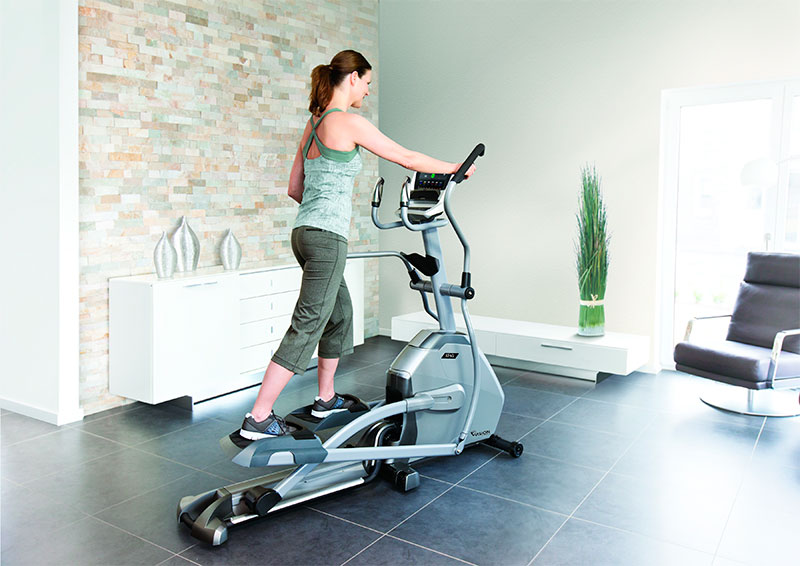
Dimensions
When buying an elliptical simulator, first of all, its dimensions should be considered. If you have a small living space, then the acquisition of a professional electromagnetic simulator will make you say goodbye to a couple of precious square meters. In this case, it is better to stay on a small magnetic model or search for a folding ellipsoid.
"Load capacity"
Despite all the promises of manufacturers, the simulator is better to buy with a good margin of perceived weight - about 20 kg. In this case, you will avoid breakage of the frame and the imminent failure of the resistance unit. Only be guided by the heaviest member of the family - even if he does not plan to practice on the device, he will definitely want to try a couple of times.
Flywheel - location and weight
Depending on the location of the flywheel, elliptical trainers are divided into two types:
1. Rear wheel drive - perfectly mimic skiing or running, as the body of the athlete during a workout leans forward. Such models are suitable for people as tall as 180 cm, while they themselves have relatively small size and good stability.
2. In the front wheel drive between the pedals of the ellipse, the distance is smaller, and the body of the person during training is located directly. These simulators are considered more effective for losing weight.
In some models designed for home use, the flywheel can be located in the center, that is, just between the feet of the athlete. Such cross-trainers in their characteristics differ little from the front-wheel drive, but occupy less room space in the room.
By weight, the flywheels of elliptical trainers are divided into small and large. The first go no heavier than 8-10 kg and give less stress to the muscles. The second group includes flywheels weighing from 10 to 35-40 kg.They seriously increase the cost of the projectile, but they differ in smoothness and allow you to maximize pumping on the simulator.
Step length
This parameter depends on the level of your physical training and to some extent on the length of your legs:
- 30-40 cm - suitable for beginners or people of short stature, but still try to get closer to the upper value of this range;
- 40-50 cm - optimal for amateur athletes and those with average height;
- Over 50 cm - the level of the pros, but also suitable for tall people with long legs.
If you are going to train for a long time and seriously on your ellipsoid or are looking for a model for the whole family, you should invest in the option with the possibility of adjusting the step length.
Load levels and workout programs
The more load levels are provided in the simulator, the smoother the transition from one speed to another - keep this in mind when learning the functionality of the ellipsoid. It is unrealistic to choose an effective mode if you fly away from the pedals on the first “gear”, and turn them on the second “hard”. The largest number of load levels can boast electromagnetic elliptical trainers.
As for training programs, it’s not the number of training programs that is most important here, but the availability of regimes suitable for your goals. Then the computer itself will build a "track" and the load, taking into account the increase in the pulse rate, in order to recreate the ideal conditions for losing weight, building muscle or endurance training.
Computer availability
Devices equipped with a computer, always cost more, but those who are going to do without the supervision of an experienced coach, you should not spare money on smart stuffing.
Thanks to the computer, you can monitor the progress of the workout and your condition, because all the necessary indicators will be displayed on the screen of the minicomputer:
- Kilometers traveled;
- Pedal speed;
- Exercise time;
- Pulse rate;
- Calorie consumption;
- Created load.
It is desirable that your device has a built-in heart rate monitor, and it is better that its sensors are located in the handles of the simulator. Of course, they are not very accurate readings, but you do not have to be confused in the wires. The data from the heart rate monitor is not just displayed on the computer screen, it is also needed to calculate the heart rate-dependent training programs (if this function is provided in the ellipsoid).
Which elliptical trainer to choose
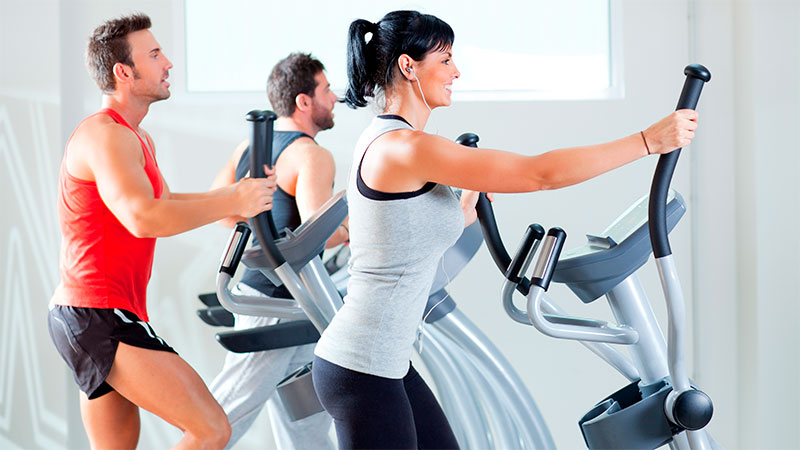
1. If you need an inexpensive simulator, it is better to choose a belt-based mechanical model without a minicomputer. The flywheel of a cheap device will pull a kilogram by 8, and the load levels here will be at a minimum. But to get the effect of training is still possible by simply changing the position of the body. Dimensions of the simulator, its “carrying capacity” and step size should be chosen to suit your height, weight and experience of training.
2. Looking for a not too expensive, but quite functional ellipsoid? Take a magnetic device with a flywheel of 10-15 kg. A small computer, 15-20 load levels and 3-4 basic training programs will suit you completely and at the same time will not hit hard on your pocket.
3. If your budget and living space allow you to purchase an expensive electromagnetic device - feel free to buy. This is the best option of all now existing. Just look for a model with a flywheel of at least 10-15 kg, well, and the built-in computer will provide you with any load conditions you want. It is also desirable that smart electronics "know" several pulse-dependent programs and monitor all major health indicators.
The cost of elliptical trainers
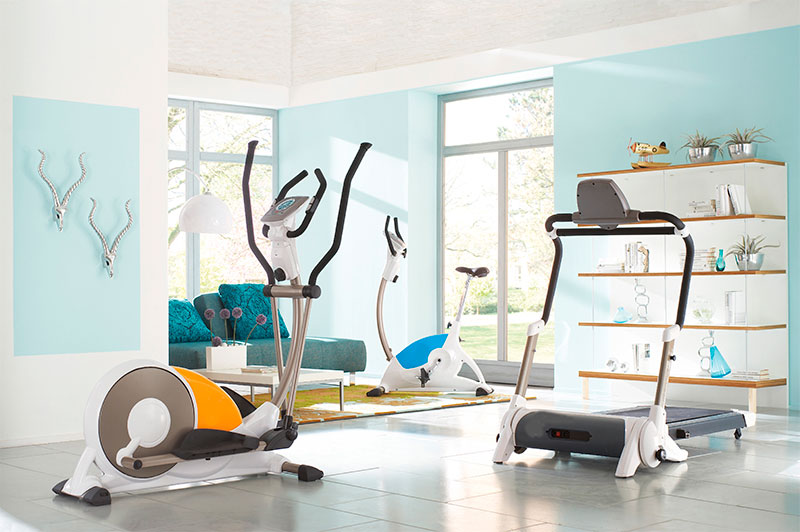
1. Mechanical simulators can be purchased at prices ranging from 8,000 to 22,000 rubles.
2. The cost of magnetic ranges from 8500 rubles for "home" models to 250-300 thousand for professional ones.
3. Electromagnetic ellipsoids are much more expensive - they start from 17-18 thousand rubles. and reach 1.4 million.
4. Aeromagnetic models are not pleased with a wide variety, but within 90-350 thousand you can find a decent machine.
It will be interesting to friends too

